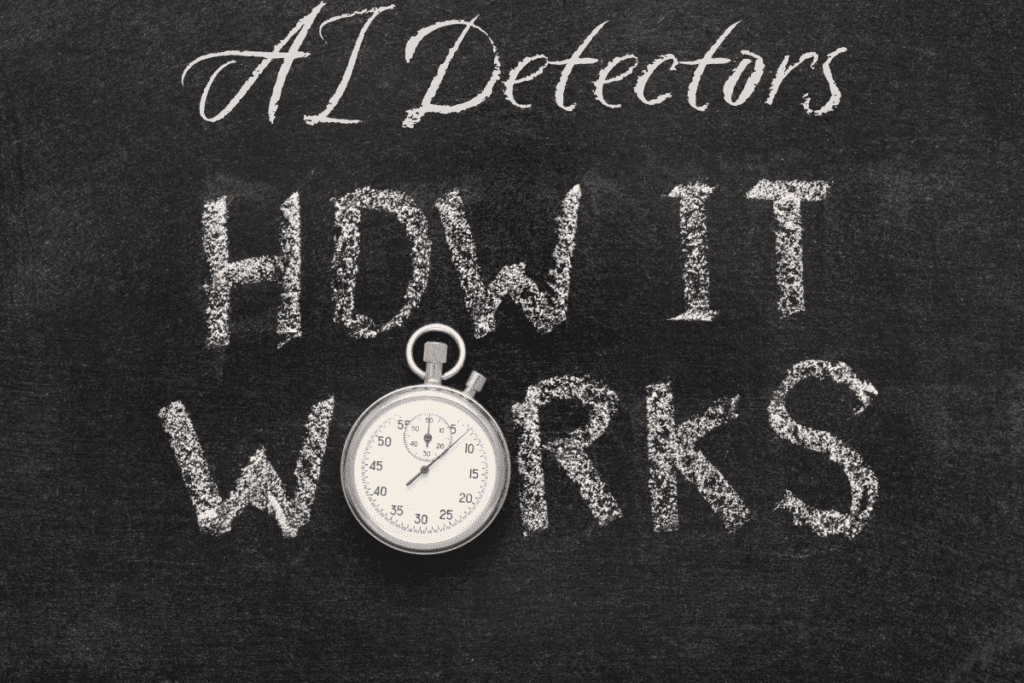How Do AI Detectors Work? Analysis Of LLM AI-Generated Text?
Confused about AI-generated text and how to detect it? It’s a modern predicament, given that no public detector has proved more than 16.7% accurate in catching such content so far. Answering the question “How Do AI detectors work?” is a “hot topic” today. From academia to professional settings, AI content is becoming more prevalent and the lines between the two are harder to discern.
This article will demystify the inner workings of AI detectors by delving into Large Language Models (LLMs), shedding light on their strengths and flaws. Get ready; we’re taking you behind-the-scenes of AI detection!
Key Takeaways
- AI detectors struggle to accurately detect AI – generated text, with several public detectors flagging historical human content as produced by ai.
- Large Language Models (LLMs) exhibit limitations when detecting AI-generated content, which can lead them to draw inaccurate conclusions about whether a human or a machine constructed a piece of content.
- Factors such as sample size and continuous research efforts play important roles in improving the accuracy of AI detection tools.
- Advancements in technology, deep neural networks, natural language processing techniques, and collaboration with industry leaders are driving improvements in AI writing detection.

What Aspects of AI Content Make It Distinguishable from Human Written Content?
While AI-generated content has become increasingly sophisticated, there are still subtle and sometimes not-so-subtle differences that can help distinguish it from human-authored content.
1. Repetition: AI often uses the same phrases or data more frequently than a human writer would. This is usually due to the limited dataset the algorithm is trained on.
2. Lack of Intuition: Humans understand context and subtlety in a way that AI doesn’t. AI can make assertions or assumptions that seem odd or out of place because it lacks the intuition a human writer would employ.
3. Lack of Personal Experience: AI content lacks personal insights, emotions, or anecdotes. Even if AI tries to mimic this, it often comes off as hollow or insincere.
4. Difficulty Understanding Sarcasm and Models of Speech: AI may struggle with humor, sarcasm, and idioms. These are hard to model because they rely heavily on nuanced social and cultural contexts.
5. Inability to Make Value Judgements: AI cannot form opinions or make moral, ethical, or aesthetic judgments like a human writer can.
6. Error in Complex Grammar: While some AI programs are excellent at producing grammatically correct sentences, they can sometimes struggle with more complex structures, leading to awkward phrasing or improper use of words.
7. Incoherence in Long Texts: Although AI can produce short, coherent texts, they often struggle with longer, more complex narratives. They have difficulty maintaining coherence and sticking to the topic for extended lengths of text.
8. Overuse of Keywords: Due to their programming, AI may use keywords excessively, leading to unnatural sounding texts.
9. Lack of Creativity: While AI can generate content based on existing data, they cannot produce genuinely original ideas or creative works like human writers.
10. Difficulty with Non-Literal Interpretation: AI programs mostly interpret texts literally, and thus might miss out on nuanced, nonliteral, or figurative meanings.
What Are Some Metrics used by AI Content Detection Tools?
AI detectors typically use multiple metrics to determine whether or not a text is human-generated. This is because no single metric is perfect and can reliably distinguish between human-generated and AI-generated text. By using multiple metrics, AI detectors can get a more accurate picture of the text’s origin.
How is Perplexity used as a Metric in AI Detection?
Perplexity is a measure of how well a language model predicts the next word or sequence of words given a context. It quantifies the uncertainty or confusion in predicting the next word. Lower perplexity indicates that the model is better at predicting the next word and has a more coherent language representation.
In content creation, perplexity can be used to assess the fluency and coherence of the generated content. A language model with low perplexity is more likely to generate content that flows naturally and is easier to understand for the readers.
Researchers measure perplexity using the Humphreys Perplexity Scale. They calculate it by taking the logarithm of the probability that the next word in a sequence is the most likely word.
A score of 0 indicates perfect predictability, meaning that the next word is always the most likely word. A score of 100 indicates the worst possible predictability, meaning that the next word is never the most likely word.
Human-generated text typically has a perplexity score of around 20-30. This means that human-generated text is relatively predictable, but it is not completely predictable. AI-generated text, on the other hand, typically has a perplexity score of around 50-100. This means that AI-generated text is much less predictable than human-generated text.
How to use Burstiness for AI Content Detection?
Burstiness refers to the distribution of topics or ideas within a piece of content. It measures how frequently certain topics or ideas appear in a short span of time. A bursty content has frequent occurrences of certain topics, resulting in a non-uniform distribution.
In content creation, burstiness can be used to evaluate the diversity and freshness of the generated content. A bursty content may indicate repetitive or redundant information, while a non-bursty content may lack depth and variety. This metric is measured on a scale of the same name, the Burstiness Index.
What does Burstiness measure? Burstiness measures the variability of the sentence lengths in a text.
This metric is calculated by taking the ratio of the variance of the sentence lengths to the mean of the sentence lengths. A score of 0 indicates perfectly uniform text, meaning that all of the sentences are the same length. A score of 1 indicates perfectly bursty text, meaning that the sentences are all different lengths.
Deciphering the Flesch-Kincaid Reading Ease
The Flesch-Kincaid Reading Ease score gauges the readability of a text. A higher score denotes easier comprehension. Typically, human-generated content scores around 60-70, while AI-generated text hovers between 40-50. This difference can influence a reader’s engagement and understanding of the content.
Exploring the Type-token Ratio
The type-token ratio measures the diversity of vocabulary in content. A higher ratio suggests a broader variety of words, a trait often seen in human-authored text. In contrast, AI-generated content tends to have a more limited vocabulary range, making it less varied.
The Inaccuracy of AI Detectors for LLM AI-Generated Text
LLM AI-Generated Text often poses challenges for AI detectors due to its inaccuracy. The more sophisticated generative ai content creation tools become, the closer the overlap between human-generated and ai-generated text. This overlap makes it difficult for an ai detection tool using stand-alone metrics to distinguish between content written by an ai or human. As such, ai detection tools work by using multiple metrics to gain a more accurate picture of the text’s origin.
Unreliability of LLMs as detectors
Large Language Models (LLMs) come with a significant degree of unreliability as detectors of AI-generated text.
The false promise that pervades detection tools claims they can unerringly identify text produced by LLMs. However, this fails to hold-up under scrutiny and has caused issues, especially in academia. Current methods utilized by LLM detection models demonstrate an alarming level of inaccuracy and inconsistency when it comes to reliable detection.
This makes them less than ideal for users seeking accurate results in detecting content generated by AI technologies like ChatGPT or other generative AI systems.
Consequently, if we place our trust solely in these Large Language Model detectors, we risk venturing down a perilous path, drawing inaccurate conclusions about whether a human or a machine constructed a piece of content.
How Reliable are AI Content Detectors with Formal Writing and Speeches?
Pasting text from speeches such as the Emancipation Proclamation or the Declaration of Independence can present challenges to some AI detectors due to the distinct linguistic norms of their era. I recently tested this on a list of the popular ai detectors. Surprisingly enough, some of these historical speeches are actually flagged by an ai detection tool. This nuance can cause issues with AI writers and formal writing, such as speeches. The language and syntax used in these historical documents differ considerably from contemporary language, potentially confounding AI detectors primarily trained on modern datasets.
When humans write in an exceptionally formal manner, it can indeed pose challenges for AI detectors designed to distinguish between human-authored and AI-generated content. The heightened formality, characterized by structured syntax, precise vocabulary, and a lack of colloquialisms or idiomatic expressions, might resemble the output of certain AI models. AI often generate text that is grammatically correct and devoid of personal biases or informalities.
Why should educators be cautious with AI Detectors? The nature of formal written text could increase the likelihood of a false positive, leading the detector to misclassify human-authored content as AI-generated. It’s essential to recognize that while AI detectors are becoming increasingly sophisticated, they are not infallible and can be influenced by the style and complexity of the content they analyze.
Additionally, the high degree of stylization in documents like the Declaration of Independence, characterized by rhetorical flourishes and formal structures, diverges from everyday language patterns, posing another layer of complexity for AI analysis. Ambiguity is another hurdle; while humans can engage in rich debates over the nuanced interpretations of statements in these documents, AI detectors might falter when faced with content that isn’t straightforward.
Over the centuries, as these historical documents have been transcribed, digitized, or reproduced, variations or errors might have crept in. Analyzing a version with such discrepancies can lead an AI detector astray. Lastly, the profound significance of these speeches is rooted in a deep cultural and historical context, something that AI, focused on textual analysis, might not fully comprehend.
Limitations of sophisticated prompts and fine-tuning
Sophisticated prompts and fine-tuning are valuable tools for improving AI performance, but they also come with their own set of limitations. AI systems may struggle to interpret complex prompts correctly, especially if the prompt language is ambiguous or unclear.
Sometimes, this results in the system generating text that does not align with what was intended by the user.
Fine-tuning an AI’s model might not always yield the desired improvements. The process demands a lot of time and resources as it requires continuous adjustments based on several rounds of trials and errors.
Even after extensive fine-tuning, there’s still a possibility that detectors can give false positives or negatives when identifying whether content is human-written or generated by AI like Large Language Models (LLMs).
This challenges underscores why we need to address these barriers before we can depend entirely upon sophisticated prompts and fine-tuned models for accurate detection of ai-generated content.
Challenges and Limitations in AI Writing Detection
AI writing detection faces various challenges and limitations in terms of accuracy, including factors like sample size and the need for further research.
Discussion on the accuracy of detectors
AI detectors play a crucial role in identifying AI-generated content, but their accuracy is not yet perfect. Testing has shown that no public detector scores higher than 16.7% detection accuracy on large language model (LLM) and mixed samples.
OpenAI’s AI text detector, for example, correctly identifies only 26% of AI-written text as “likely AI-written.” Many sites claiming to catch AI-generated text still fail due to the improving quality of AI-generated content and outdated training examples used by detectors.
Clearly, we need more research and development to enhance the accuracy and reliability of these detectors in identifying AI-generated content.
Factors affecting accuracy, such as sample size and follow-on research
The accuracy of AI detectors can be influenced by certain factors, such as the sample size used for training and testing. A larger sample size generally leads to better accuracy in detecting AI-generated text.
Additionally, follow-on research plays a crucial role in improving the effectiveness of these detectors. By continuously researching and refining their algorithms, developers can enhance the accuracy and reliability of AI detection tools.
These factors are key considerations in ensuring that AI detectors are able to effectively identify AI-generated content amidst human-written text.
Tools and Techniques for AI Writing Detection
Classifiers and embeddings are commonly used tools for AI writing detection, allowing the identification and analysis of AI-generated content.
Using classifiers and embeddings
Classifiers and embeddings are commonly used in the field of AI to detect AI-generated text. These tools work by training a classification model on known samples of AI-written or human-written text. The model then uses these samples to learn patterns and distinguish between AI-generated content and human-written content. By analyzing the linguistic features and patterns of the text, classifiers can identify if the content has been generated by an AI language model. Embeddings, on the other hand, represent words or phrases as numerical vectors in a high-dimensional space. This allows AI detectors to compare similarities and differences between different pieces of text, helping them recognize patterns that indicate the presence of AI-generated content.
Detection of AI-generated content
AI detectors use prediction patterns to detect AI-generated content. They examine the text for specific characteristics that distinguish it from human-written text. Large-language models make it challenging to differentiate between robot-generated words and real ones. Researchers rely on systematic differences between human and machine text to develop accurate AI detectors. DetectGPT is a well-regarded zero-shot method for detecting AI-generated content.
The role of Google in detecting ChatGPT
Google has the potential to play a role in detecting ChatGPT and other AI-generated text. Currently, there is no concrete evidence of Google having a system in place to detect AI or ChatGPT-generated content.
However, various tools and techniques have been proposed for recognizing AI-written text, although they are not foolproof. One such method is DetectGPT, which uses a zero-shot approach by generating paraphrases for input text and comparing them to detect AI-generated content.
While AI writing detection tools might not achieve 100% accuracy, using combined methods can help pinpoint the origin of AI-generated text. Developers have created specific online tools and methodologies to identify text that ChatGPT generates.
The future of AI writing detection looks promising with advancements in technology and detection methods. Detecting AI-generated content is becoming increasingly important, and manual detection practices have shown some efficacy.
To learn more about the challenges, tools, and the role of Google in detecting AI-generated text, continue reading.
Advancements in technology and detection methods
Advancements in technology and detection methods have played a crucial role in improving the accuracy of AI writing detection. Here are some notable developments:
Enhanced Machine Learning Algorithms: Researchers have refined machine learning algorithms to better distinguish between human-written and AI-generated content. These algorithms analyze patterns, syntax, grammar, and semantic structures to identify text created by large language models.
Deep Neural Networks: Researchers use deep neural networks, such as convolutional neural networks (CNN) and recurrent neural networks (RNN), to extract meaningful features from text data. These networks effectively learn complex patterns in both human-written and AI-generated content, which improves detector reliability.
Natural Language Processing Techniques: Researchers employ natural language processing (NLP) techniques to analyze AI-generated text characteristics. NLP models use linguistic features like word usage, sentence structure, and contextual information to distinguish between human-written and machine-generated content.
Domain-specific Detection Models: Researchers have created domain-specific detection models to tackle the unique challenges different content types present. For example, specialized detectors exist for AI-generated images, videos, audio files, and synthetic data.
Collaboration with Industry Leaders: Collaboration between researchers and industry leaders has significantly contributed to advancements in AI writing detection technology. Companies like Google have developed sophisticated tools that leverage their vast resources and datasets to detect AI-generated content accurately.
Continuous Research Efforts: Ongoing research in the field of AI writing detection continues to drive improvements in technology and methods. Scholars and experts are constantly exploring new approaches to enhance the accuracy of detectors by analyzing factors such as sample size, follow-on research, cross-validation techniques, and bias reduction strategies.
Importance of detecting AI-generated content
Accurate detection and identification of AI-generated content is of utmost importance in today’s digital landscape. With advances in generative AI technology, the line between human-written and AI-generated text has become increasingly blurred.
Detecting AI-generated content allows us to maintain transparency and integrity in online communication, ensuring that users can trust the authenticity of information they encounter.
It also helps content creators, marketers, and researchers understand the impact and influence of automated writing on various platforms. As researchers work towards developing more reliable detectors, we can better navigate this evolving landscape by distinguishing between content created by humans and that generated by AI systems.
Manual detection practices and their efficacy
As recommended for ethical ai content creation, manual detection practices play a crucial role in the efficacy of AI writing detection. These practices involve human reviewers carefully examining and analyzing content to identify signs of text generated by AI.
As AI models become more sophisticated, it becomes increasingly challenging for human reviewers to accurately distinguish between AI-generated text and human-written content. Nevertheless, manual detection remains an essential component in the ongoing efforts to improve the accuracy and reliability of AI writing detectors.
Learning how to incorporate ai content into our daily lives will become more and more important. This is similar to how we moved to using the Internet, and all but replaced Encyclopedia Britannica and Libraries, for book reports.
Conclusion
AI detectors play a crucial role in identifying if text is written by ai. While they are not perfect and face challenges in accuracy, these detectors rely on analyzing language patterns and systematic differences between human-written and machine-generated text to detect AI content.
Researchers and developers continue to make efforts to improve the effectiveness of AI detectors and enhance their ability to identify AI-generated text accurately.
If you liked this article, remember to subscribe to MiamiCloud.com. Connect. Learn. Innovate.








